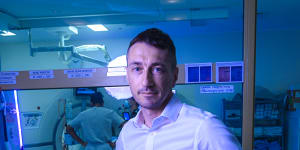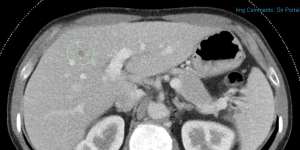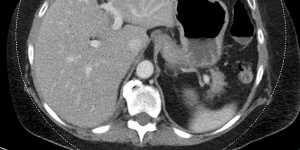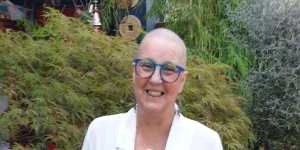“Incidentalomas”,or incidental findings,are being detected in up to 40 per cent of patients who undergo scans for unrelated health conditions,according to a new study.

Associate Professor Tom Sutherland,director of medical imaging at St Vincent’s Hospital.Justin McManus
Associate Professor Tom Sutherland,the director of medical imaging at St Vincent’s Hospital in Melbourne,said the rate of incidental findings in his patients had more than doubled during his 21-year career in medicine.
He attributes this rise to advances in medical imaging and the increasing use of scans.
“We’re seeing things that we never used to see,” he said.
“When I started,a CT scan of a brain was 24 slices,and now it is 240. The abdomen and pelvis slices used to be five-millimetre slices;now we are down to one millimetre.”

A CT scan shows an unsuspected liver nodule (dark area in the green ring),which is harmless.Supplied
He said the vast majority of these incidental findings were harmless,with just 1 per cent serious enough to warrant treatment. These more serious findings include cancers,aneurysms and blood clots.
,which followed a common prostate procedure,has shone a spotlight on the phenomenon.
But the rise in incidental findings has also thrown up some ethical dilemmas.
While the early detection of life-threatening disease is beneficial,benign findings can trigger anxiety for patients.
They can also lead to invasive procedures such as biopsies,radiation from follow-up imaging,and additional costs to the health system,. The study estimates that incidentalomas crop up in up to 40 per cent of CT scans.

A CT scan of the abdomen showing unsuspected fatty liver,which can cause chronic liver disease,cancer and cardiovascular disease.Supplied
The study’s co-author,Professor Ian Scott,decided to look into the phenomenon after a 72-year-old patient recently presented with kidney stone pain at his Queensland hospital. An abdominal CT scan revealed a lesion in his pancreas,which doctors worried was cancer.
“They did a major operation where they took out the pancreas and unfortunately,he didn’t do too well after that,” the director of internal medicine at Princess Alexandra Hospital recalled.
“There were quite a few complications. Because they took his pancreas out,he developed diabetes and malabsorption syndrome and lost a lot of weight. When they inspected the lesion they discovered it wasn’t cancer.”
He would like to see a reduction in unwarranted scans being ordered by doctors.
“People are over-reliant on the technology,whereas if you base your clinical judgment on good history taking,physical examination,basic blood tests and risk assessments,you often don’t need to do the imaging,” he said.
“For the one in 20 who might have something nasty,you are treating 19 patients and causing them the risk of harms.”
Kym Walker is forever grateful for her incidental diagnosis. After tripping over some rocks while holidaying in Apollo Bay in 2021,the Geelong mother of three had a scan that revealed she had broken a bone in her back. But it also revealed something more concerning:some lesions on her liver.

Kym Walker was diagnosed with breast cancer in 2021 after tripping over some rocks and breaking her back.Supplied
A week later she was diagnosed with stage 4 breast cancer,which had spread to her liver and bones.
“I was stunned that it was stage 4 already,” the now 64-year-old said. “I was thankful I had broken my back and found it earlier.”
Walker lost her mother to breast cancer when she was 34 and has had breast screens every two years. She was not due for her next one for another month and said the incidental diagnosis gave her a six-week head start on treatment.
The Pilates and karate instructor is still undergoing treatment,and after exhausting all options available through the Pharmaceutical Benefits Scheme,is paying for groundbreaking new chemotherapy drugs that cost her $10,000 every three weeks.
One of her friends has set up,which Walker describes as her last hope.
“If this doesn’t work there is no other option for me,” she said. “I will be given a terminal diagnosis.”
Royal Australian and New Zealand College of Radiologists president Professor John Slavotinek,who is also a co-author of the study published in theMedical Journal of Australia,said a fear of litigation and older patients with more than one disease were also fuelling the rise in incidental findings.
He said context and patient preferences were vital when it came to responding to these medical findings.
A clinical trial of a breast cancer drug has worked wonders for patient Nancy Calarco.
“If you have a history of cancer,a new nodule somewhere becomes far more interesting than in a 20-year-old with no such history.”
Dr Anita Clarke,head of urology at St Vincent’s Hospital,said it was becoming increasingly common for CT scans to serendipitously detect masses in the kidney when screening for other ailments.
She said of these incidental findings,25 per cent were significant cancers that needed to be promptly treated and around 50 per cent were low-grade cancers that could initially be managed with observation but might need to be ultimately removed. She estimates that around 25 per cent were benign kidney conditions.
“In many instances now,we will say you will most likely die with this in your body[rather] than from it,” she said.
“But patients understandably get quite distressed when they are told they have a cancer in their body with no symptoms. It’s a real minefield.”
Make the most of your health,relationships,fitness and nutrition with our Live Well newsletter. every Monday.